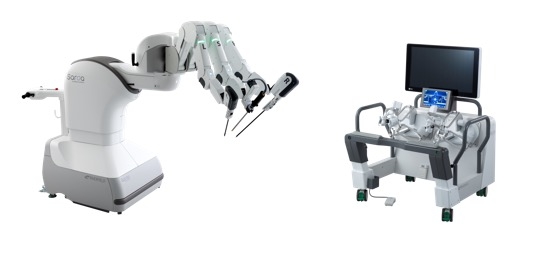Riverfield Develops the World’s First Surgical Robot with Force Sensing
VxWorks Supports the Saroa Surgical System
MARKET BACKGROUND
The da Vinci platform developed by Intuitive Surgical in the U.S. was previously the most widely used surgical robot in Japan. However, three major issues were identified: lack of sense of force, or kinesthetic perception; arm interference; and cost.
Existing surgical robots do not provide kinesthetic sensation during surgery, which medical professionals felt could hamper precision. In addition, the long and large arms often touched each other and bumped into doctors during surgery. Finally, surgical robots were extremely large and expensive. They weighed nearly one ton, requiring floor reinforcement at the installation site. They were too large to fit in elevators and through doors. The standard Japanese power supply of 100V would not supply the robots’ required 200V, requiring modifications to the operating room’s power distribution panel. Some hospitals gave up on the idea of introducing these systems
DEVELOPMENT CHALLENGES
Since a surgical robot reaches inside the patient’s body, it must be plated to withstand preoperative cleaning. Interference from electrocautery and other devices are also considerations. Riverfield has responded to these challenges by reproducing force feedback through air pressure. The precision control technology of the pneumatic system provides kinesthetic sense essential for precise surgical procedures, such as gripping, grasping, and pulling. Saroa allows the doctors operating the robot to feel as though they are operating directly with their own hands, which is expected to enhance the precision of surgery.
APPROACH
A significant advantage of Riverfield’s pneumatic system is that it can provide kinesthetic feedback without using a force sensor. While this makes these systems less expensive and more suitable for compact and lightweight applications, it also presents a challenge.
Pneumatic systems have many components and are complex and difficult to control. Furthermore, although earlier versions could perform surgery, there was still room for improvement, compared to electric systems, in terms of high-speed, precise drive.
To achieve advanced control, Saroa selected VxWorks as the best real-time operating system to meet Riverfield’s requirements of fast response performance, high reliability, and safety.
“With VxWorks, we can do hardware real-time processing at the one-millisecond level. This allows us to control pneumatic forces and other applications at high speed and with precision. In addition, because this is the medical field, high reliability, safety, and security are important. VxWorks has an extensive track record in the field of medical devices that require control, such as robots, MRIs, and endoscopes, so we feel very comfortable using it as a real-time OS for medical equipment,” says Masao Kanazawa, manager of the Software Design Department of Riverfield’s Design and Development Division.
RESULTS
Riverfield’s Saroa surgical robot is most notable for its force sensing, but it also provides other advantages.
“Saroa weighs just over half the weight of existing robots and is about the height of a person. Its lightweight and space-saving features allow easy movement between operating rooms and within the facility, and more flexible operation,” says Riverfield CEO Kotaro Tadano. He also notes that Saroa was developed with a goal of reducing cost compared to other systems. Saroa uses one less arm than competing products and keeps the monitor and endoscope separate. This makes the device less expensive and more compact and light-weight. “It also makes it easier to work with assistants and prevents arm interference,” notes Kanazawa. Hospitals can use the system with their existing monitors.
With the expiration of the da Vinci solution’s major patents, the market is now more accessible for Riverfield, which will continue to improve Saroa and is considering its next generation of surgical robots. The company plans to expand into Asia, Europe, and the United States. And because surgical robots in Japan are currently found only in large university hospitals, Riverfield also hopes to expand use of the Saroa surgical robot into smaller and rural hospitals as well.


